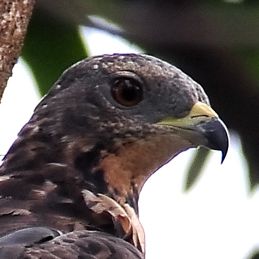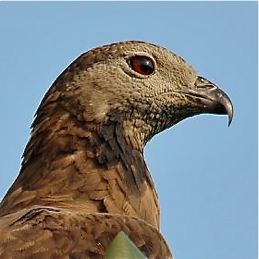On 26th March 2008, KC Tsang reported an Oriental Honey-buzzard (Pernis ptilorhyncus) peeping into his kitchen: “Looks like this OHB loves to hang around my kitchen window, and the estate where I am staying. The same kind of behavior was evident too the previous years. It will announce its presence by blasting pass my kitchen window as it did this early morning.
“…the assam tree (Tamarindus indicus) is its favourite roosting place for the night. Managed to flush the fellow out, and he went to perch on the lamp post (left)… then it flew off to the nearby mahogany tree (Swietenia macrophylla), perched on the trunk (below)… Then he decided to fly off for a while.
“…in half an hour’s time the bird returned and perched on top of the tree which was directly opposite my bedroom window… The last encounter, two or more years ago, that I had with this bird was at Lowland Road when he buzzed me by flying low, just over my head, and landed on the mango tree (Mangifera indica)…”
Originally thought to be one and the same bird, KC was alerted by an observant and experienced Malaysian birder that there were actually two birds. The first bird that flew from the lamp post to the mahogany tree was a juvenile. The juvenile can be recognised by its yellow cere, the leathery band of skin covering the base of the bill, into which the nostrils open (below left). The second bird that arrived half an hour later was an adult male, as seen in his grey cere (below right).
Urban Singaporeans are becoming more familiar with this large raptor. An encounter with this bird never fails to impress people as many are only familiar with the smaller mynas, bulbuls, starlings or even the orioles. Larger birds like the crows obviously do not excite but the hornbills do. Now the Oriental Honey-buzzard is making its presence felt. In the same month we had a few other sightings.
Earlier in the month we posted an account of Koh Jia Hwei’s encounter with one in a tree among the Housing Board highrise apartment buildings.
In the same month, Choo Teik Ju was visibly excited when a large Oriental Honey-buzzard passed overhead when he was at Gibraltar Crescent: “I was stunned when I saw a sudden and quick shadow passing by me few yards away and after a while, maybe ten seconds later, lots of birds (Peaceful Dove, White-breasted Kingfisher, Eurasian Tree Sparrow) were flying in a rush to escape this creature. When I looked at the surrounding carefully, I saw this raptor tearing apart an Eurasian Tree Sparrow. The raptor later flew onto the roof top (above).”
The Oriental Honey-buzzard breeds in Siberia, Sakhalin, North China, Manchuria, Korea and Japan. In winter it moves as far south as Indonesia and the Philippines. A few birds end up in Singapore, where it is a common winter visitor and passage migrant. Although seen in all months of the year, it is more abundant from November to March.
Singapore is one big Garden City and the many trees planted along roads, park-connectors, mini-parks and large regular parks obviously are paying dividends. These trees attract bees and wasps, and unless the hives are massive, they would invariably be left unmolested by the authorities. The bird feeds mainly on the larvae of these hymenopterans, as well as the honey combs. Even the larvae of paper wasps are food for the bird. In addition, it takes various insects and occasionally lizards, frogs, birds and small mammals.
Obviously there is plenty of food around for this raptor throughout the year.
All image by KC Tsang except the raptor on the roof, by Choo Teik Ju.














3 Responses